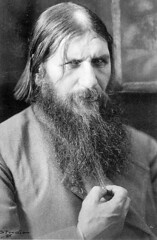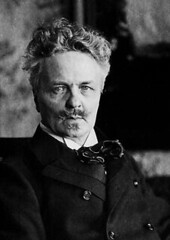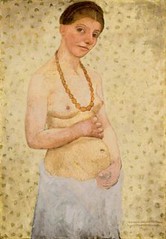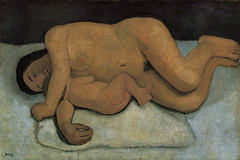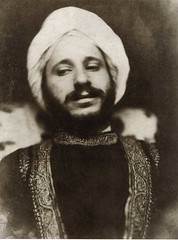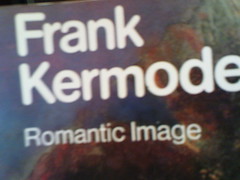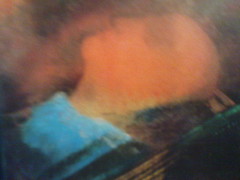Only at times like this, when viewing clips of what looks to be an exceptional film, Elem Klimov‘s Agony about the life of Rasputin, see previous post[1], discovered via one of my new facebook friendships, do we realize what utter tripe we are usually watching. The score by Alfred Schnittke is half of the attraction of this film.
Monthly Archives: January 2009
Rasputin’s member and Strindberg’s women
Tomorrow Thursday 22nd is Grigori Rasputin‘s and August Strindberg‘s anniversary. Rasputin is then at 140, Strindberg at 160.
Edel‘s Rasputin: Dark Servant of Destiny (1995)
Rasputin is known today for the sensationalized accounts as playboy, mystical healer, debauched religious charlatan and political demiurge. Accounts of his life have often been based on dubious memoirs, hearsay, and legend, such as the story of his most honest organ.
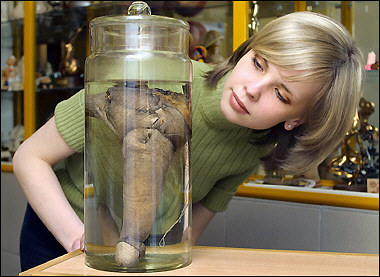
Rasputin’s member, fact or fiction?
Strindberg is known for his misogyny (Strindberg’s misogyny), his interest in oneirism and the unconsciousness (A Dream Play and a chronology of the discovery of the unconscious in the 19th century) and as a founding father of literary realism.
CLIP DELETED
Mike Figgis‘s Miss Julie, the”And now kiss my shoe”-scene
Your best introduction to the life of Strindberg is his autobiographical novel Inferno. Written in French in 1897 at the height of Strindberg’s troubles with both censors and women, the book is concerned with Strindberg’s life both in and after he lived in Paris, and explores his various obsessions, including alchemy, occultism, and Swedenborgianism, and showing signs of paranoia and neuroticism.
Inferno has often been cited as proof of Strindberg’s own personal neuroses, such as a persecution complex, but evidence also suggests that Strindberg, although experiencing mild neurotic symptoms, both invented and exaggerated much of the material in the book for dramatic effect.
Happy birthday Radley Metzger!
Unidentified photo of Radley Metzger
Radley Metzger, American filmmaker, distributor and producer turns 80 today.
If all roads lead to Rome, Metzger‘s birthday leads to The Image, one of the sexiest films of the 1970s.
She lifts her skirt for her mistress.
The Image / The Punishment of Anne (1975) – Radley Metzger [Amazon.com] [FR] [DE] [UK]
The Image is a 1975 film directed by Radley Metzger. The film is based upon the 1956 French novel L’Image, written by Catherine Robbe-Grillet, wife of Alain Robbe-Grillet.
The story of Jean (played by Carl Parker), a writer who meets an old friend, Claire (Marilyn Roberts), at a party and is soon drawn into her world of sadomasochism along with her slave, Anne (Mary Mendum, aka Rebecca Brooke, and Metzger’s girlfriend at the time).
Watch out for the fountain scene if you ever get to see this gem, it makes very clever Freudian use of a free Parisian spectacle.
The film is World Cinema Classic #80.
Introducing Paula Modersohn-Becker
While researching Aktivismus (in relationship to my Gaston Burssens binge[1]), I came across the powerful work of German female painter Paula Modersohn-Becker.
Paula Modersohn-Becker (1876 – 1907) is considered a representative of early expressionism.
She produced nude self-portraits of which the two depicted are perhaps examples. I’m too tired to check.
The one painting with the baby is particularly foretelling. When Paula’s long-lived wish to conceive and bear a child was fulfilled, her daughter Mathilde (Tillie) Modersohn was born but the joy became soon overshadowed by tragedy, as Paula Modersohn-Becker died suddenly in Worpswede on November 20th from an embolism.
Since she died young, she is one of the few 20th century artists whose work is in the public domain.
I am a romantic at heart. Of the dark variety.
I am a romantic at heart. Of the dark variety.
I recently purchased The Romantic Image[1] by Frank Kermode. It mentions Simeon Solomon as the garret-living bohemian/starving artist/einzelganger.
I quote:
I research Simeon Solomon and find W. H. Auden‘s For The Time Being: A Christmas Oratorio, which has the scene, “The Meditation of Simeon,” which begins:
- “As long as there were any roads to amnesia and anaesthesia still to be explored, any rare wine or curiosity of cuisine as yet untested, any erotic variation as yet unimagined or unrealized, any method of torture as yet undevised, any style of conspicuous waste as yet unindulged, any eccentricity of mania or disease as yet unrepresented, there was still hope that man had not been poisoned but transformed….”
What Auden describes is jadedness, the primary malady of all romantics.
Two pioneers of “outsider music”
Two pioneers of “outsider music” (space age pop) celebrate their anniversaries today.
[Youtube=http://www.youtube.com/watch?v=fs0f4LEaSCo&]
At 70 there is French electronic music producer Jean-Jacques Perrey, with “E. V. A.” [1]. Perrey is alive.
[Youtube=http://www.youtube.com/watch?v=-Jk6WvkBl1g&]
At 80 there is Mexican bandleader and pioneer of lounge music Juan García Esquivel with “Cherokee” [2]. Esquivel died in 2002.
Egon Schiele, Jane Birkin and Brian Eno, or a cult item if there ever was one
Egon Schiele Excess & Punishment
[Youtube=http://www.youtube.com/watch?v=CmOFvKmivxU&]
From the film “Egon Schiele Exzess und Bestrafung” (1981) starring Mathieu Carrière, Jane Birkin and Christine Kaufmann with an original score by Brian Eno. A cult item if there ever was one. Dedicated to Rafaela for her appreciation of sensualism and Esotika for his appreciation of European cinema.
For those of you with prurient interests (wink, wink), scrub to 3:00 and various subsequent points in time you will have to find for yourself.
Eno’s score is mesmerizing and blissful.
From my wiki:
Egon Schiele Exzess und Bestrafung, also known as Excess and Punishment(English) and Egon Schiele, enfer et passion (French) is a 1980 film based on the life of the Austrian artist Egon Schiele. It stars Mathieu Carriere as Schiele with Jane Birkin as his artist muse Wally and Christine Kaufmann as his wife Edith and Christina Van Eyck as her sister. The film is essentially a depiction of obsession and its constituents of sex, alcohol and uncontrolled emotions. Set in Austria during the Great War Schiele is depicted as the agent of social change leading to destruction of those he loves and ultimately of himself.
The film is an international co-production with actors of German, French, Dutch and English origin. It was directed by Herbert Vesely and produced by Dieter Geissler and Robert Hess. The cinematography is by Rudolf Blahacek and the haunting music is by Brian Eno. The English language version of the film is entitled Egon Schiele Excess & Punishment.
Introducing Gaston Burssens (1896 – 1965)
Fabula rasa (1945) by Gaston Burssens (this edition 1964)
I am not much of a fiction reader, nor have I ever been much of a poetry reader. My favorite literature is books about books. Literary criticism or literary theory.
I make exceptions.
The best work I read last year was Michaux’s Plume[1] which happens to be a work of prose poetry, a genre which can be traced most readily to Baudelaire and Poe. A genre which is plotless but nevertheless more concrete than pure poetry.
Saturday I bought the work above. It is worth its price for the introductory notes alone.
Literary critic Paul de Wispelaere reviewed it in the chapter “De groteske wereld en de wereld van de groteske,” in his collection Het Perzische Tapijt (1966). In this essay de Wispelaere juxtaposes Fabula Rasa with the paraprose of Gust Gils, another Flemish writer who wrote in the tradition of the literary grotesque. Fabula Rasa’s Belgian-French counterpart is Plume by Henri Michaux.
While researching this post I also stumbled upon prose by Flanders’ cult poet par excellence Paul Van Ostaijen: De bende van de stronk (The stump gang, 1932, grotesques). I will want a copy of that.
Edgar Allan Poe @200
Edgar Allan Poe, American writer and poet @200
A photograph of a daguerreotype of Edgar Allan Poe 1848,
first published 1880
Edgar Allan Poe (January 19, 1809 – October 7, 1849) was an American writer, and one of the leaders of the American Romanticism. Best known for his tales of the macabre and mystery, Poe was one of the early American practitioners of the short story and a progenitor of detective fiction and crime fiction. During his lifetime he was more popular in France (thanks to the translations of Baudelaire) than in his native country. After his premature death at the age of 40 he became internationally renowned. The Japanese writer Edogawa Rampo derived his pseudonym of his name. He came to the attention of 20th century audiences via the low-budget film adaptations by Roger Corman starring Vincent Price.
If you only want to read one story by Poe, read “Loss of Breath.”
“Loss of Breath: A Tale Neither in nor Out of “Blackwood” (1832) is a short story by Poe, first published on June 9 or November 10 1832. It concerns a man who suspects that his wife has stolen his breath.
David Ketterer describes the story as: “A surrealistic fantasy in which the idea that death involves not loss of life but merely loss of breath is combined with a whimsical but, for biographers of Poe’s psyche, revealing equation between loss of breath and loss of sexual potency on the narrator’s wedding night”.[1]
“Behold me then safely ensconced in my private boudoir, a fearful instance of the ill consequences attending upon irascibility—alive, with the qualifications of the dead—dead, with the propensities of the living—an anomaly on the face of the earth—being very calm, yet breathless.”
…
“The purchaser took me to his apartments and commenced operations immediately. Having cut off my ears, however, he discovered signs of animation. He now rang the bell, and sent for a neighboring apothecary with whom to consult in the emergency. In case of his suspicions with regard to my existence proving ultimately correct, he, in the meantime, made an incision in my stomach, and removed several of my viscera for private dissection. “
The Romantic Image
I went to the city yesterday and bought:
- The Romantic Image[1][2] by Frank Kermode
- Venus’ lusthof[3] by Leonard de Vries, includes translation of Académie des dames ou le meursius francais and other curiosa
- Fabula Rasa by Gaston Burssens
Did not buy Sarenco : le triptyque du cinéma mobile, 1983-1987[4]: Félix Guattari, Eugenio Miccini, Luigi Serravalli and The Dark Comedy: The Development of Modern Comic Tragedy[5] by J. L. Styan, 1968.
The Romantic Image by Frank Kermode
The Romantic Image by Frank Kermode
The Romantic Image (1957) is a book on the “image” in Romantic poetry by Frank Kermode.
In its preface Kermode says he is indebted to Romantic Agony by Italian critic Mario Praz, The Romantic Soul and the Dream by Swiss critic Albert Béguin, The Mirror and the Lamp by M. H. Abrams and The Symbolist Aesthetic in France, 1885-1895 by A. G. Lehmann.

